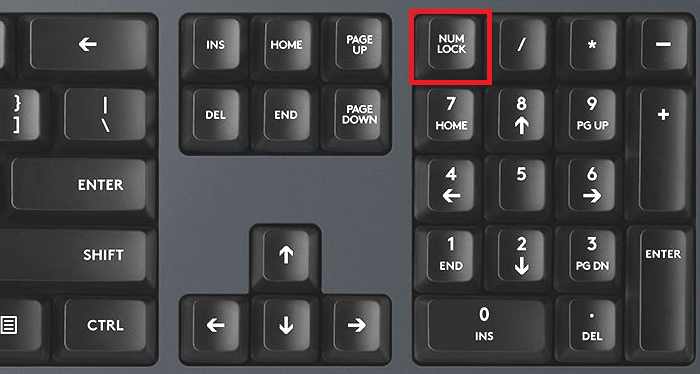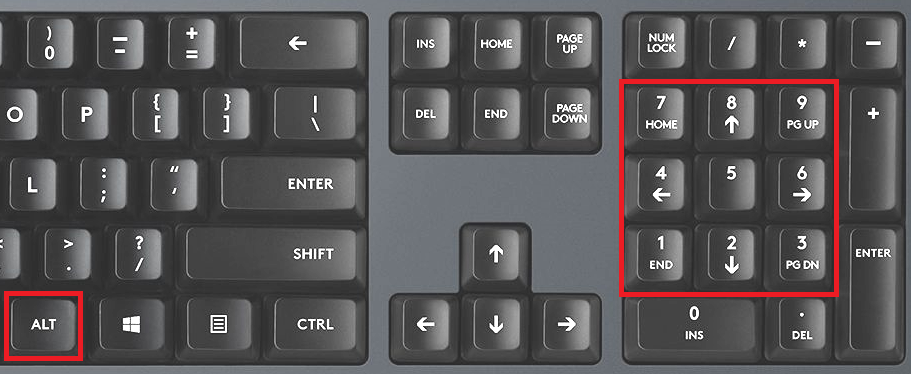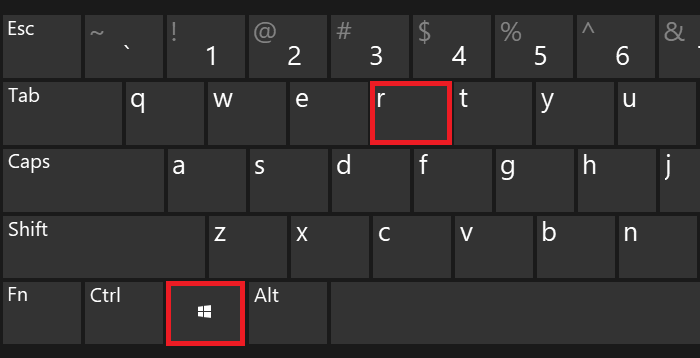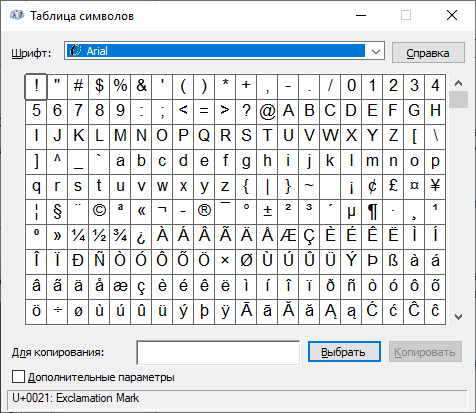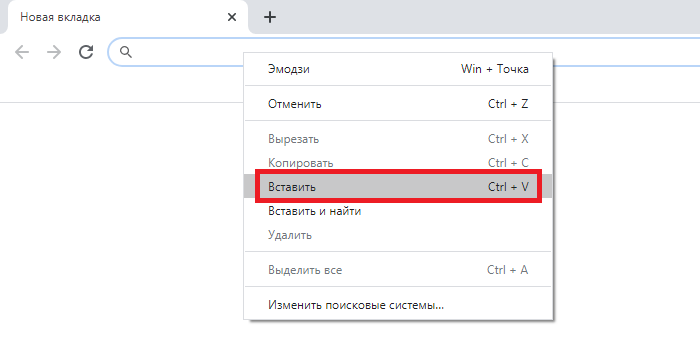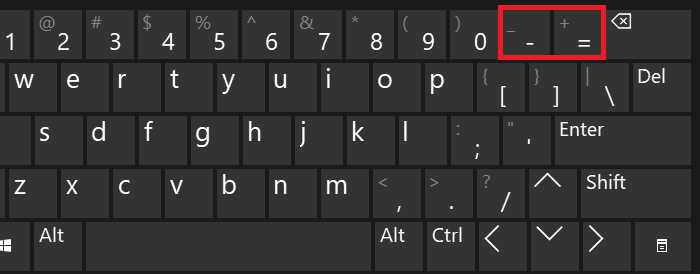Как поставить знак плюс-минус (±) на клавиатуре?
Существует много способов, благодаря которым можно нажать «плюс/минус» на клавиатуре. Итак, сегодня мы разберём все способы для Windows и для других устройств.
- Способ 1. Таблица символов
- Способ 2. Код
- Способ 3. Копирование
Способ 1. Таблица символов
У Windows есть программа, который называется «таблица символов» и в неё входят все символы, которых нет на обычной клавиатуре. Среди этих символов есть и знак ±, умножения, деления, больше или равно и все основные символы, поэтому если вам понадобится такие знаки, то вы можете зайти в данную таблицу символов.
Чтобы найти «таблицу символов» необходимо зайти в «пуск», затем во «все программы», дальше «стандартные», там выбираем «служебные» и ищем там «таблицу символов».
Этот способ поможет тем, у кого компьютер но ОС Windows.
А если вам нужен этот знак в приложении Word, то вы можете воспользоваться таблицей символов от этого приложения. Она находится верхней панели, ищите символы и выбираете знак.
Способ 2. Код
Существует такой способ, которым пользуются все аналитики, математики. Он не такой сложный, просто необходимо запомнить, нужную комбинацию цифр. А именно сначала нажимаем на «NumLock». Клавиша находится в правой части клавиатуры, вверху больших цифр. Затем после того как вы нажали на эту клавишу зажимаете «Alt” и набираете код 0177 и сразу же выходит ± там, где установлен курсор.
Если у вас ноутбук, то на вашей клавиатуре нет того места с большими цифрами, вы можете найти клавиатуру NumLock в верхней части клавиатуры. На некоторых ноутбуках находится на F11, на некоторых на F10 и других кнопках F.
Никто не отменял такой простой способ, копирования. Это не совсем удобно, если вам нужно этот знак постоянно, но если он понадобился вам один раз, то можно найти в интернете знак ± и просто скопировать его в нужное место.
± ∓
Знак плюс-минус (±) — математический символ, который ставится перед некоторым выражением и означает, что значение этого выражения может быть как положительным, так и отрицательным. Часто используется, например, для указания:
- пределов изменения каких-либо параметров;
- инструментальной точности измерения физической величины;
- ожидаемого разброса значений статистически измеренного параметра;
- интервала значений результата в приближённых математических вычислениях.
Примеры
Пример 1: фраза «напряжение в сети должно быть 220 ± 4,5 вольт» означает, что напряжение должно быть в диапазоне от 215,5 до 224,5 вольт.
Пример 2, где символ «плюс-минус» надо понимать буквально, как указание альтернативы из двух вариантов — известная формула для вычисления двух корней квадратного уравнения 
Эта формула — компактная запись, объединяющая формулы для первого и второго корня:
Пример 3, аналогичный второму, тригонометрический:
Пример 4. Здесь истолкование символа плюс-минус иное: надо выбрать знак одночлена в зависимости от его номера в ряду:
Знак минус-плюс
У знака плюс-минус есть вариант: знак 
Это компактная запись двух формул:
Другие случаи употребления
В шахматной нотации символ ± означает, что после соответствующего хода преимущество имеют белые, а символ ∓ — что преимущество у чёрных.
Кодировка
| Символ | Код в Юникоде |
Название в Юникоде |
Название | HTML шестн. |
HTML десят. |
HTML обозн. |
|---|---|---|---|---|---|---|
 |
U+00B1 | Plus-minus sign | Символ плюс-минус | ± | ± | ± |
 |
U+2213 | Minus-or-Plus sign | Символ минус-плюс | ∓ | ∓ |
- В ISO 8859-1 символ плюс-минус имеет код 0xB1.
- В TeX знаки плюс-минус и минус-плюс кодируются как
pmиmpсоответственно. - В системе Microsoft Windows для ввода символа плюс-минус можно, прижав клавишу Alt , ввести на цифровой клавиатуре число 0177.
- В системах Linux/Unix сформировать символ плюс-минус можно последовательностью compose +-.
- На компьютерах Макинтош плюс-минус кодируется вводом символов ⇧ Shift += .
См. также
- История математических обозначений
- Минус
- Плюс
- Таблица математических символов
| |
|---|
| Плюс ( + ) • Минус ( − ) • Знак умножения ( · или × ) • Знак деления ( : или / ) • Знак корня ( √ ) • Знак равенства ( =, ≈, ≡ и др.) • Знаки неравенства ( ≠, >, < и др.) • Бесконечность ( ∞ ) • Знак интеграла ( ∫ ) • Факториал ( ! ) • Вертикальная черта ( | ) • Знак градуса ( ° ) • Минута градуса ( ′ ) • Секунда градуса ( ″ ) • Штрих ( ′ ) • Звёздочка ( * ) • Обратная косая черта, бэкслеш ( ) • Процент ( % ) • Промилле ( ‰ ) • Тильда ( ~ ) • Циркумфлекс ( ^ ) • Плюс-минус ( ± ) • Обелюс ( ÷ ) • Десятичный разделитель ( , или . ) |
| Математика • История математических обозначений |
Содержание
- Добавление знака «плюс минус» через раздел «Символ»
- Добавление знака «плюс минус» с помощью специального кода
- Метод первый
- Метод второй
Нередко во время работы в Microsoft Word возникает необходимость написать в документе знак, который отсутствует на клавиатуре. Так как далеко не все пользователи знают, как добавить тот или иной знак или символ, многие из них ищут подходящий значок в интернете, а затем копируют его и вставляют в документ. Данный метод вряд ли можно назвать неправильным, но существуют и более простые, удобные решения.
Мы неоднократно писали о способах вставки различных символов в текстовом редакторе от Microsoft, и в данной статье мы расскажем, как поставить знак “плюс минус” в Ворде.
Урок: MS Word: вставка символов и знаков
Как и в случае с большинством символов, “плюс минус” также можно добавить в документ несколькими способами — о каждом из них мы расскажем ниже.
Урок: Вставка знака суммы в Ворде
Добавление знака «плюс минус» через раздел «Символ»
1. Кликните в том месте страницы, где должен находиться знак “плюс минус”, и переключитесь на вкладку “Вставка” на панели быстрого доступа.
2. Нажмите на кнопку “Символ” (группа инструментов “Символы”), в выпадающем меню которой выберите “Другие символы”.
3. Убедитесь в том, что в открывшемся диалоговом окне в разделе “Шрифт” установлен параметр “Обычный текст”. В разделе “Набор” выберите “Дополнительная латиница-1”.
4. В появившемся списке символов найдите “плюс минус”, выберите его и нажмите “Вставить”.
5. Закройте диалоговое окно, знак “плюс минус” появится на странице.
Урок: Вставка знака умножения в Word
Добавление знака «плюс минус» с помощью специального кода
Каждый символ, представленный в разделе “Символ” программы Майкрософт Ворд, имеет свое кодовое обозначение. Зная этот код, вы сможете значительно быстрее добавлять необходимый знак в документ. Помимо кода, нужно также знать и клавишу или комбинацию клавиш, преобразовывающую введенный код в необходимый знак.
Урок: Комбинации клавиш в Word
Добавить знак “плюс минус” с помощью кода можно двумя способами, а сами коды вы можете увидеть в нижней части окна “Символ” непосредственно после нажатий на выбранный знак.
Метод первый
1. Кликните в том месте страницы, где нужно поставить символ “плюс минус”.
2. Зажмите на клавиатуре клавишу “ALT” и, не отпуская ее, введите цифры “0177” без кавычек.
3. Отпустите клавишу “ALT”.
4. В выбранном вами месте страницы появится знак “плюс минус”.
Урок: Как в Ворд написать формулу
Метод второй
1. Кликните там, где будет находиться знак “плюс минус” и переключитесь на английский язык ввода.
2. Введите код “00B1” без кавычек.
3. Не перемещаясь с выбранного места страницы, нажмите клавиши “ALT+X”.
4. Введенный вами код будет преобразован в знак “плюс минус”.
Урок: Вставка знака математического корня в Word
Вот так просто можно поставить символ “плюс минус” в Ворде. Теперь вы знаете о каждом из существующих методов, а то, какой из них выбрать и использовать в работе — решать только вам. Рекомендуем вам просмотреть и другие символы, имеющиеся в наборе текстового редактора, возможно, там вы найдете еще что-то полезное.
From Wikipedia, the free encyclopedia
| ± | |
|---|---|
|
Plus–minus sign |
|
| In Unicode | U+00B1 ± PLUS-MINUS SIGN (±, ±, ±) |
| Related | |
| See also | U+2213 ∓ MINUS-OR-PLUS SIGN (∓, ∓, ∓) |
The plus–minus sign, ±, is a mathematical symbol with multiple meanings:
- In mathematics, it generally indicates a choice of exactly two possible values, one of which is obtained through addition and the other through subtraction.[1]
- In experimental sciences, the sign commonly indicates the confidence interval or uncertainty bounding a range of possible errors in a measurement, often the standard deviation or standard error.[2] The sign may also represent an inclusive range of values that a reading might have.
- In medicine, it means «with or without».[3][4]
- In engineering, the sign indicates the tolerance, which is the range of values that are considered to be acceptable, safe, or which comply with some standard or with a contract.
- In botany, it is used in morphological descriptions to notate «more or less».
- In chemistry, the sign is used to indicate a racemic mixture.
- In chess, the sign indicates a clear advantage for the white player; the complementary minus-or-plus sign, ∓, indicates the same advantage for the black player.[5]
- In electronics, this sign may indicate a dual voltage power supply, such as ±5 volts means +5 volts and -5 volts, when used with audio circuits and operational amplifiers.
- In linguistics, it may indicate a distinctive feature, such as [±voiced].[6]
History[edit]
A version of the sign, including also the French word ou («or»), was used in its mathematical meaning by Albert Girard in 1626, and the sign in its modern form was used as early as 1631, in William Oughtred’s Clavis Mathematicae.[7]
Usage[edit]
In mathematics[edit]
In mathematical formulas, the ± symbol may be used to indicate a symbol that may be replaced by either the plus and minus signs, + or −, allowing the formula to represent two values or two equations.[8]
For example, given the equation x2 = 9, one may give the solution as x = ±3. This indicates that the equation has two solutions, each of which may be obtained by replacing this equation by one of the two equations x = +3 or x = −3. Only one of these two replaced equations is true for any valid solution. A common use of this notation is found in the quadratic formula
which describes the two solutions to the quadratic equation ax2 + bx + c = 0.
Similarly, the trigonometric identity
can be interpreted as a shorthand for two equations: one with + on both sides of the equation, and one with − on both sides. The two copies of the ± sign in this identity must both be replaced in the same way: it is not valid to replace one of them with + and the other of them with −. In contrast to the quadratic formula example, both of the equations described by this identity are simultaneously valid.
The minus–plus sign, ∓, is generally used in conjunction with the ± sign, in such expressions as x ± y ∓ z, which can be interpreted as meaning x + y − z or x − y + z, but not x + y + z nor x − y − z. The upper − in ∓ is considered to be associated to the + of ± (and similarly for the two lower symbols), even though there is no visual indication of the dependency.
However, the ± sign is generally preferred over the ∓ sign, so if both of them appear in an equation, it is safe to assume that they are linked. On the other hand, if there are two instances of the ± sign in an expression, without a ∓, it is impossible to tell from notation alone whether the intended interpretation is as two or four distinct expressions.
The original expression can be rewritten as x ± (y − z) to avoid confusion, but cases such as the trigonometric identity are most neatly written using the «∓» sign:
which represents the two equations:
Another example where the minus–plus sign appears is
A third related usage is found in this presentation of the formula for the Taylor series of the sine function:
Here, the plus-or-minus sign indicates that the term may be added or subtracted, in this case depending on whether n is odd or even, the rule can be deduced from the first few terms. A more rigorous presentation of the same formula would multiply each term by a factor of (−1)n, which gives +1 when n is even, and −1 when n is odd. In older texts one occasionally finds (−)n, which means the same.
When the standard presumption that the plus-or-minus signs all take on the same value of +1 or all −1 is not true, then the line of text that immediately follows the equation must contain a brief description of the actual connection, if any, most often of the form “where the ‘±’ signs are independent” or similar. If a brief, simple description is not possible, the equation must be re-written to provide clarity; e.g. by introducing variables such as s1, s2, … and specifying a value of +1 or −1 separately for each, or some appropriate relation, like 
In statistics[edit]
The use of ± for an approximation is most commonly encountered in presenting the numerical value of a quantity, together with its tolerance or its statistical margin of error.[2] For example, 5.7 ± 0.2 may be anywhere in the range from 5.5 to 5.9 inclusive. In scientific usage, it sometimes refers to a probability of being within the stated interval, usually corresponding to either 1 or 2 standard deviations (a probability of 68.3% or 95.4% in a normal distribution).
Operations involving uncertain values should always try to preserve the uncertainty—in order to avoid propagation of error. If 



A percentage may also be used to indicate the error margin. For example, 230 ±10% V refers to a voltage within 10% of either side of 230 V (from 207 V to 253 V inclusive).[citation needed] Separate values for the upper and lower bounds may also be used. For example, to indicate that a value is most likely 5.7, but may be as high as 5.9 or as low as 5.6, one may write 5.7+0.2
−0.1.
In chess[edit]
The symbols ± and ∓ are used in chess notation to denote an advantage for white and black, respectively. However, the more common chess notation would be to only use + and –.[5] If several different symbols are used together, then the symbols + and − denote a clearer advantage than ± and ∓. When finer evaluation is desired, three pairs of symbols are used: ⩲ and ⩱ for only a slight advantage; ± and ∓ for a significant advantage; and +– and –+ for a potentially winning advantage, in each case for white or black respectively.[9]
Encodings[edit]
- In Unicode: U+00B1 ± PLUS-MINUS SIGN
- In ISO 8859-1, -7, -8, -9, -13, -15, and -16, the plus–minus symbol is code 0xB1hex. This location was copied to Unicode.
- The symbol also has a HTML entity representations of
±,±, and±. - The rarer minus–plus sign is not generally found in legacy encodings, but is available in Unicode as U+2213 ∓ MINUS-OR-PLUS SIGN so can be used in HTML using
∓or∓. - In TeX ‘plus-or-minus’ and ‘minus-or-plus’ symbols are denoted
pmandmp, respectively. - Although these characters may also be produced using underlining or overlining + symbol ( + or + ), this is deprecated because the formatting may be stripped at a later date, changing the meaning. It also makes the meaning less accessible to blind users with screen readers.
Typing[edit]
- Windows: Alt+241 or Alt+0177 (numbers typed on the numeric keypad).
- Macintosh: ⌥ Option+⇧ Shift+= (equal sign on the non-numeric keypad).
- Unix-like systems: Compose,+,- or ⇧ Shift+Ctrl+u B1space (second works on Chromebook)
- In the Vim text editor (in Insert mode): Ctrl+k +- or Ctrl+v 177 or Ctrl+v x B1 or Ctrl+v u 00B1
- AutoCAD shortcut string:
%%p
Similar characters[edit]
Look up 士, 土, or 干 in Wiktionary, the free dictionary.
The plus–minus sign resembles the Chinese characters 土 (Radical 32) and 士 (Radical 33), whereas the minus–plus sign resembles 干 (Radical 51).
See also[edit]
- ≈ (approximately equal to)
- Engineering tolerance
- Plus and minus signs
- Sign (mathematics)
- Table of mathematical symbols
References[edit]
- ^ Weisstein, Eric W. «Plus or Minus». mathworld.wolfram.com. Retrieved 2020-08-28.
- ^ a b Brown, George W. (1982). «Standard deviation, standard error: Which ‘standard’ should we use?». American Journal of Diseases of Children. 136 (10): 937–941. doi:10.1001/archpedi.1982.03970460067015. PMID 7124681.
- ^ Naess, I. A.; Christiansen, S. C.; Romundstad, P.; Cannegieter, S. C.; Rosendaal, F. R.; Hammerstrøm, J. (2007). «Incidence and mortality of venous thrombosis: a population-based study». Journal of Thrombosis and Haemostasis. 5 (4): 692–699. doi:10.1111/j.1538-7836.2007.02450.x. ISSN 1538-7933. PMID 17367492.
- ^ Heit, J. A.; Silverstein, M. D.; Mohr, D. N.; Petterson, T. M.; O’Fallon, W. M.; Melton, L. J. (1999-03-08). «Predictors of survival after deep vein thrombosis and pulmonary embolism: a population-based, cohort study». Archives of Internal Medicine. 159 (5): 445–453. doi:10.1001/archinte.159.5.445. ISSN 0003-9926. PMID 10074952.
- ^ a b Eade, James (2005), Chess For Dummies (2nd ed.), John Wiley & Sons, p. 272, ISBN 9780471774334.
- ^ Hornsby, David. Linguistics, A Complete Introduction. p. 99. ISBN 9781444180336.
- ^ Cajori, Florian (1928), A History of Mathematical Notations, Volume I: Notations in Elementary Mathematics, Open Court, p. 245.
- ^ «Definition of PLUS/MINUS SIGN». www.merriam-webster.com. Retrieved 2020-08-28.
- ^ For details, see Chess annotation symbols#Positions.
From Wikipedia, the free encyclopedia
| ± | |
|---|---|
|
Plus–minus sign |
|
| In Unicode | U+00B1 ± PLUS-MINUS SIGN (±, ±, ±) |
| Related | |
| See also | U+2213 ∓ MINUS-OR-PLUS SIGN (∓, ∓, ∓) |
The plus–minus sign, ±, is a mathematical symbol with multiple meanings:
- In mathematics, it generally indicates a choice of exactly two possible values, one of which is obtained through addition and the other through subtraction.[1]
- In experimental sciences, the sign commonly indicates the confidence interval or uncertainty bounding a range of possible errors in a measurement, often the standard deviation or standard error.[2] The sign may also represent an inclusive range of values that a reading might have.
- In medicine, it means «with or without».[3][4]
- In engineering, the sign indicates the tolerance, which is the range of values that are considered to be acceptable, safe, or which comply with some standard or with a contract.
- In botany, it is used in morphological descriptions to notate «more or less».
- In chemistry, the sign is used to indicate a racemic mixture.
- In chess, the sign indicates a clear advantage for the white player; the complementary minus-or-plus sign, ∓, indicates the same advantage for the black player.[5]
- In electronics, this sign may indicate a dual voltage power supply, such as ±5 volts means +5 volts and -5 volts, when used with audio circuits and operational amplifiers.
- In linguistics, it may indicate a distinctive feature, such as [±voiced].[6]
History[edit]
A version of the sign, including also the French word ou («or»), was used in its mathematical meaning by Albert Girard in 1626, and the sign in its modern form was used as early as 1631, in William Oughtred’s Clavis Mathematicae.[7]
Usage[edit]
In mathematics[edit]
In mathematical formulas, the ± symbol may be used to indicate a symbol that may be replaced by either the plus and minus signs, + or −, allowing the formula to represent two values or two equations.[8]
For example, given the equation x2 = 9, one may give the solution as x = ±3. This indicates that the equation has two solutions, each of which may be obtained by replacing this equation by one of the two equations x = +3 or x = −3. Only one of these two replaced equations is true for any valid solution. A common use of this notation is found in the quadratic formula
which describes the two solutions to the quadratic equation ax2 + bx + c = 0.
Similarly, the trigonometric identity
can be interpreted as a shorthand for two equations: one with + on both sides of the equation, and one with − on both sides. The two copies of the ± sign in this identity must both be replaced in the same way: it is not valid to replace one of them with + and the other of them with −. In contrast to the quadratic formula example, both of the equations described by this identity are simultaneously valid.
The minus–plus sign, ∓, is generally used in conjunction with the ± sign, in such expressions as x ± y ∓ z, which can be interpreted as meaning x + y − z or x − y + z, but not x + y + z nor x − y − z. The upper − in ∓ is considered to be associated to the + of ± (and similarly for the two lower symbols), even though there is no visual indication of the dependency.
However, the ± sign is generally preferred over the ∓ sign, so if both of them appear in an equation, it is safe to assume that they are linked. On the other hand, if there are two instances of the ± sign in an expression, without a ∓, it is impossible to tell from notation alone whether the intended interpretation is as two or four distinct expressions.
The original expression can be rewritten as x ± (y − z) to avoid confusion, but cases such as the trigonometric identity are most neatly written using the «∓» sign:
which represents the two equations:
Another example where the minus–plus sign appears is
A third related usage is found in this presentation of the formula for the Taylor series of the sine function:
Here, the plus-or-minus sign indicates that the term may be added or subtracted, in this case depending on whether n is odd or even, the rule can be deduced from the first few terms. A more rigorous presentation of the same formula would multiply each term by a factor of (−1)n, which gives +1 when n is even, and −1 when n is odd. In older texts one occasionally finds (−)n, which means the same.
When the standard presumption that the plus-or-minus signs all take on the same value of +1 or all −1 is not true, then the line of text that immediately follows the equation must contain a brief description of the actual connection, if any, most often of the form “where the ‘±’ signs are independent” or similar. If a brief, simple description is not possible, the equation must be re-written to provide clarity; e.g. by introducing variables such as s1, s2, … and specifying a value of +1 or −1 separately for each, or some appropriate relation, like 
In statistics[edit]
The use of ± for an approximation is most commonly encountered in presenting the numerical value of a quantity, together with its tolerance or its statistical margin of error.[2] For example, 5.7 ± 0.2 may be anywhere in the range from 5.5 to 5.9 inclusive. In scientific usage, it sometimes refers to a probability of being within the stated interval, usually corresponding to either 1 or 2 standard deviations (a probability of 68.3% or 95.4% in a normal distribution).
Operations involving uncertain values should always try to preserve the uncertainty—in order to avoid propagation of error. If 



A percentage may also be used to indicate the error margin. For example, 230 ±10% V refers to a voltage within 10% of either side of 230 V (from 207 V to 253 V inclusive).[citation needed] Separate values for the upper and lower bounds may also be used. For example, to indicate that a value is most likely 5.7, but may be as high as 5.9 or as low as 5.6, one may write 5.7+0.2
−0.1.
In chess[edit]
The symbols ± and ∓ are used in chess notation to denote an advantage for white and black, respectively. However, the more common chess notation would be to only use + and –.[5] If several different symbols are used together, then the symbols + and − denote a clearer advantage than ± and ∓. When finer evaluation is desired, three pairs of symbols are used: ⩲ and ⩱ for only a slight advantage; ± and ∓ for a significant advantage; and +– and –+ for a potentially winning advantage, in each case for white or black respectively.[9]
Encodings[edit]
- In Unicode: U+00B1 ± PLUS-MINUS SIGN
- In ISO 8859-1, -7, -8, -9, -13, -15, and -16, the plus–minus symbol is code 0xB1hex. This location was copied to Unicode.
- The symbol also has a HTML entity representations of
±,±, and±. - The rarer minus–plus sign is not generally found in legacy encodings, but is available in Unicode as U+2213 ∓ MINUS-OR-PLUS SIGN so can be used in HTML using
∓or∓. - In TeX ‘plus-or-minus’ and ‘minus-or-plus’ symbols are denoted
pmandmp, respectively. - Although these characters may also be produced using underlining or overlining + symbol ( + or + ), this is deprecated because the formatting may be stripped at a later date, changing the meaning. It also makes the meaning less accessible to blind users with screen readers.
Typing[edit]
- Windows: Alt+241 or Alt+0177 (numbers typed on the numeric keypad).
- Macintosh: ⌥ Option+⇧ Shift+= (equal sign on the non-numeric keypad).
- Unix-like systems: Compose,+,- or ⇧ Shift+Ctrl+u B1space (second works on Chromebook)
- In the Vim text editor (in Insert mode): Ctrl+k +- or Ctrl+v 177 or Ctrl+v x B1 or Ctrl+v u 00B1
- AutoCAD shortcut string:
%%p
Similar characters[edit]
Look up 士, 土, or 干 in Wiktionary, the free dictionary.
The plus–minus sign resembles the Chinese characters 土 (Radical 32) and 士 (Radical 33), whereas the minus–plus sign resembles 干 (Radical 51).
See also[edit]
- ≈ (approximately equal to)
- Engineering tolerance
- Plus and minus signs
- Sign (mathematics)
- Table of mathematical symbols
References[edit]
- ^ Weisstein, Eric W. «Plus or Minus». mathworld.wolfram.com. Retrieved 2020-08-28.
- ^ a b Brown, George W. (1982). «Standard deviation, standard error: Which ‘standard’ should we use?». American Journal of Diseases of Children. 136 (10): 937–941. doi:10.1001/archpedi.1982.03970460067015. PMID 7124681.
- ^ Naess, I. A.; Christiansen, S. C.; Romundstad, P.; Cannegieter, S. C.; Rosendaal, F. R.; Hammerstrøm, J. (2007). «Incidence and mortality of venous thrombosis: a population-based study». Journal of Thrombosis and Haemostasis. 5 (4): 692–699. doi:10.1111/j.1538-7836.2007.02450.x. ISSN 1538-7933. PMID 17367492.
- ^ Heit, J. A.; Silverstein, M. D.; Mohr, D. N.; Petterson, T. M.; O’Fallon, W. M.; Melton, L. J. (1999-03-08). «Predictors of survival after deep vein thrombosis and pulmonary embolism: a population-based, cohort study». Archives of Internal Medicine. 159 (5): 445–453. doi:10.1001/archinte.159.5.445. ISSN 0003-9926. PMID 10074952.
- ^ a b Eade, James (2005), Chess For Dummies (2nd ed.), John Wiley & Sons, p. 272, ISBN 9780471774334.
- ^ Hornsby, David. Linguistics, A Complete Introduction. p. 99. ISBN 9781444180336.
- ^ Cajori, Florian (1928), A History of Mathematical Notations, Volume I: Notations in Elementary Mathematics, Open Court, p. 245.
- ^ «Definition of PLUS/MINUS SIGN». www.merriam-webster.com. Retrieved 2020-08-28.
- ^ For details, see Chess annotation symbols#Positions.
Знак плюс-минус — это математический символ, который ставится перед выражением и обозначает, что значение указанного выражения может быть как положительным, так и отрицательным. На письме его отобразить легко, а как быть в случае написания текста с помощью клавиатуры? Ничего сложного тут нет.
Первый способ
Да, на клавиатуре указанный символ вы не найдете, но его все равно можно набрать!
Для этого используем цифровую клавиатуру, что находится в правой части основной клавиатуры. Нажмите Num Lock для ее включения (при необходимости).
Затем нажмите на клавишу Alt и, удерживая ее, наберите на цифровой клавиатуре цифры 0177, после чего отпустите Alt.
Вот что вы должны увидеть:
Раскладка клавиатуры значения не имеет. Если фокус не сработал с правым Alt, воспользуйтесь левым.
Второй способ
Понадобится таблица символов Windows.
Нажмите на клавиши Win+R на клавиатуре своего устройства.
Введите команду charmap.exe и нажмите ОК.
Будет загружена таблица символов.
Рекомендуем использовать шрифт Arial, хотя можно и другой. Найдите символ плюс-минус, нажмите на него, после чего нажмите на кнопки «Выбрать» и «Копировать».
Далее вставьте символ в нужное место в тексте.
Вы должны увидеть следующее:
Третий способ
Он подходит только для некоторых текстовых редакторов от Microsoft, включая Word.
В месте, где хотите указать знак плюс-минус, введите 00B1 (B — в англоязычной раскладке), после чего сразу же нажмите на клавиши Alt+X.
Если все сделано верно, символы 00B1 будут заменены на знак плюс-минус.
Четвертый способ
Просто скопируйте символ из этой строки — ±.
Пятый способ
А можете поставить символы плюс и минус друг за другом — в некоторых случаях это вполне нормально. В русскоязычной раскладке нажмите на символ в виде плюса с зажатым Shift, а затем — тире (или попросту минус, без Shift).
Что должно получиться:
Возможно, именно этот способ вам понравится больше всего.
Знак плюс-минус ±
Значение символа
Знак плюс-минус (±) используется для указания интервала. От трёх до семи можно написать так: 5±2. На клавиатуре набрать можно комбинацией Alt+0177. Число 0177 вводятся на цифровом блоке с включённым Num Lock.
Символ «Знак плюс-минус» был утвержден как часть Юникода версии 1.1 в 1993 г.
Этот текст также доступен на следующих языках:
English;
Deutsch;
Синонимы
+-, сложить вычесть.
| Версия | 1.1 |
| Блок | Дополнение к латинице — 1 |
| Тип парной зеркальной скобки (bidi) | Нет |
| Композиционное исключение | Нет |
| Изменение регистра | 00B1 |
| Простое изменение регистра | 00B1 |
| Кодировка | hex | dec (bytes) | dec | binary |
|---|---|---|---|---|
| UTF-8 | C2 B1 | 194 177 | 49841 | 11000010 10110001 |
| UTF-16BE | 00 B1 | 0 177 | 177 | 00000000 10110001 |
| UTF-16LE | B1 00 | 177 0 | 45312 | 10110001 00000000 |
| UTF-32BE | 00 00 00 B1 | 0 0 0 177 | 177 | 00000000 00000000 00000000 10110001 |
| UTF-32LE | B1 00 00 00 | 177 0 0 0 | 2969567232 | 10110001 00000000 00000000 00000000 |


























